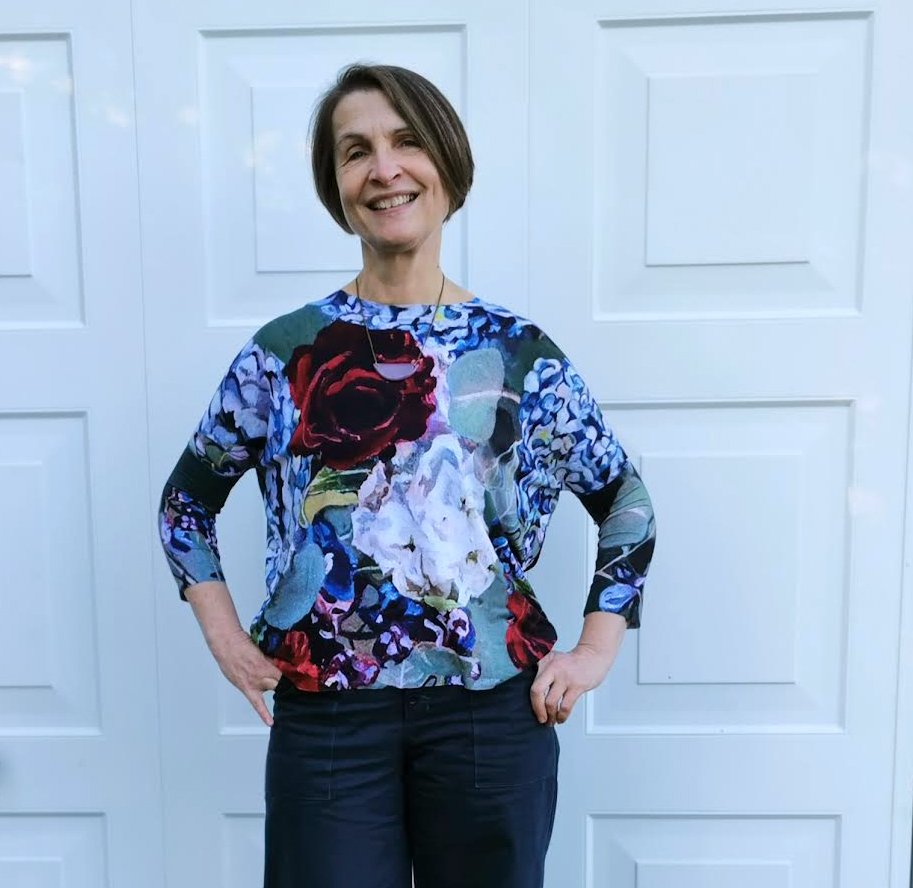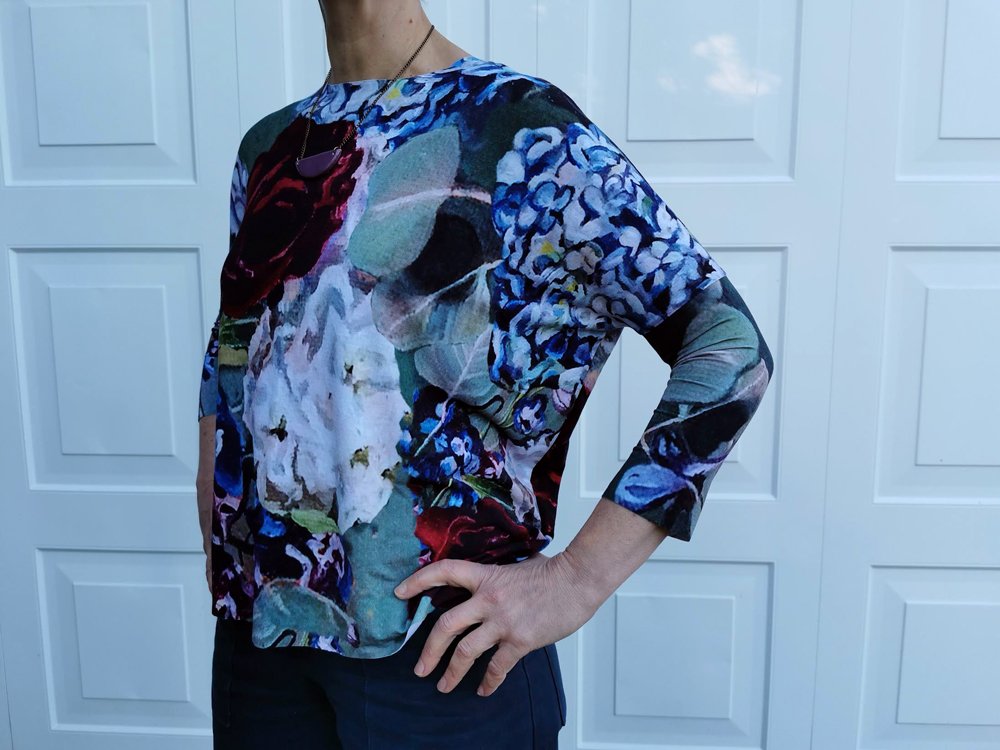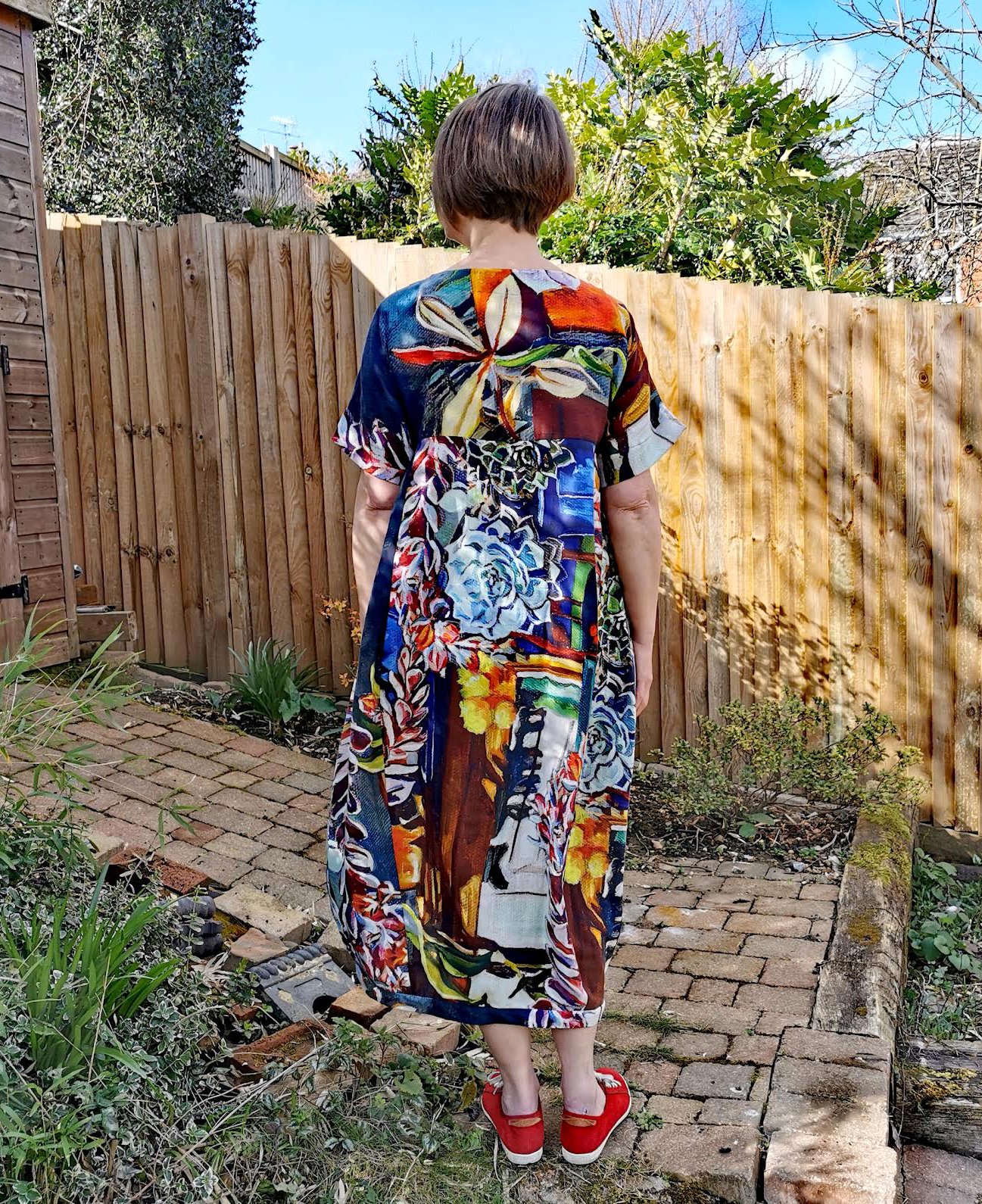Guest blog: Tips for working with large scale prints by the talented sewist, Elke.
Editor’s Note: a special thank you to @sewover50 for originally featuring Elke’s tips for large scale prints with Julia Allisson Cost Textiles on their Instagram account.
Hello! I’m Elke (@sewthreadbear on IG) and I live in UK. I came across Julia’s fabrics in 2021 just as Julia was launching her fabulous range and fell in love with the vibrant colours and large prints. I get a lot of joy and wellbeing from being in nature and visiting flower gardens, and these beautiful fabrics have combined my love of sewing with my love of nature.
I loved how other sewists were using the giant flower panels and large flower prints in their makes but was unsure sure how to use them myself. My favourite garments are boxy tops and wide pants, so I experimented with cutting up giant flower panels and hacking patterns to make the most of the glorious flowers on Julia’s fabrics!
Working with these fabrics has been a very liberating experience as the beauty of the flowers encourages you to think differently and even break some sewing rules. I feel very privileged that Julia invited me to share my tips:
TIP 1:
Choose a sewing pattern you love and will want to wear often. Don’t be scared to break up large prints or giant flowers to create a garment. My Ginger top (Pattern is Style Arc’s Archie Woven Shirt) shows what you can do with giant flower panels if you cut them up. I also like adding complimentary or contrasting plain coloured fabrics for extra interest.
The full Ginger panel. Approximately 36” wide x 58” tall, cotton poplin.
Here you can see how Elke broke the Ginger panel in half, using the upper part for the shirt front, and the lower part for the shirt back.
Elke used the top half of the Ginger panel for the front of her top (Pattern is Style Arc’s Archie Woven Shirt). She replaced the button front with a placket front to keep as much of the flower intact as possible.
Elke used the lower half of the Ginger panel for the back of her top (Pattern is Style Arc’s Archie Woven Shirt).
Notice the contrast colors Elke used for the sleeves and collar, which perfectly match the yellow/green in the Ginger panel.
TIP 2:
Trace the sewing pattern pieces onto tissue paper as complete pieces and place these on your fabric to see how the garment will look. Experiment with the placement of the print and add facings to hems to preserve as much of the print as possible.
The layout of Elke’s Sunflower top (Pattern is Tessuti Fabric’s Rae Top). Elke eliminated the side seams to allow the flower to wrap around her.
Elke’s top is made with a Sunflower panel and Tessuti Fabric’s Rae Top.
Here you can see the sunflower stem curving onto the back of Elke’s top. This top is made with a Sunflower panel and Tessuti Fabric’s Rae Top.
TIP 3:
Check the placement of motifs in the bust and crotch areas. I checked the placement of the motifs for the Como Knit pants by Style Arc to avoid placing the prominent blue succulent rosette on the crotch. The tissue pattern pieces will allow you to make a visual check how motifs would come together on the crotch seams or bust darts. Don’t get too worried about it though!
Elke’s faux jumpsuit created with the Succulent Garden Textile bamboo lycra and the Como Knit pants by Style Arc along with the Sew House 7 Tabor top.
TIP 4:
It’s always tempting to pattern match but with large prints this can use a lot of fabric and is not necessary. Aim for visual symmetry of the fabric pattern across the whole garment. I do occasionally fussy cut smaller pattern pieces but I try to avoid it if possible as it can be quite fabric hungry. I have not yet used the small scale repeat prints, but these do tend to require fussy cutting to avoid obvious repeats for example.
Elke self-drafted this top based on her favorite shirt in her closet using the Blue Bouquet Textile bamboo lycra.
TIP 5:
If you love a sewing pattern but it doesn’t make the best use of the fabric, do hack it! I hacked several patterns to remove the side seams as I did not want to break up the large flowers unnecessarily. Any of your favourite pants patterns can be hacked to remove the side seam. I used the Lander Pants by True Bias as they are my favourite pant, and the Protea Bouquet Textile in rayon was perfect for these wide leg pants.
Elke’s Lander Pants by True Bias in Protea Bouquet Textile rayon.
Elke’s Lander Pants by True Bias in Protea Bouquet Textile rayon.
Here you can see how Elke removed the side seams in the Lander Pants by True Bias to preserve the print of the Protea Bouquet Textile around the legs.
TIP 6:
With the poplin and gauze substrates, I do cut the fabric on the cross grain to make the most of the print, but wash and dry the fabric first as it will shrink differently on the cross grain. I cut the bamboo lycra jersey fabric on the grain, not on the cross grain, as jersey tends to stretch more across the width than the length and this can give you stretch where you were not expecting it.
Elke’s dress is made with Succulent Garden Textile cotton double gauze. Elke cut this dress on the cross grain, unlike her bamboo lycra faux jumpsuit, which she cut on the grain. This dress pattern is the Style Arc Sydney Designer Dress.
Elke’s Succulent Garden Textile cotton double gauze Style Arc Sydney Designer Dress.
TIP 6:
All of these tips apply to the swim knit fabrics too, except that you can cut these in any direction as they have four way stretch. I do line the swim knit fabric fully with a suitable swimwear lining as this enhances the beautiful colour of the print as well as keeping my modesty!
I have a few more of Julia’s fabrics to work with, which I’m very excited about ☺
-Elke (@sewthreadbear)
Thank you Elke for sharing your fabulous tips and gorgeous projects! You are such an inspiration to the sewing community! Be sure to check out more of her amazing sewing projects and process insights at her instragram account: @sewthreadbear.
- Julia





















